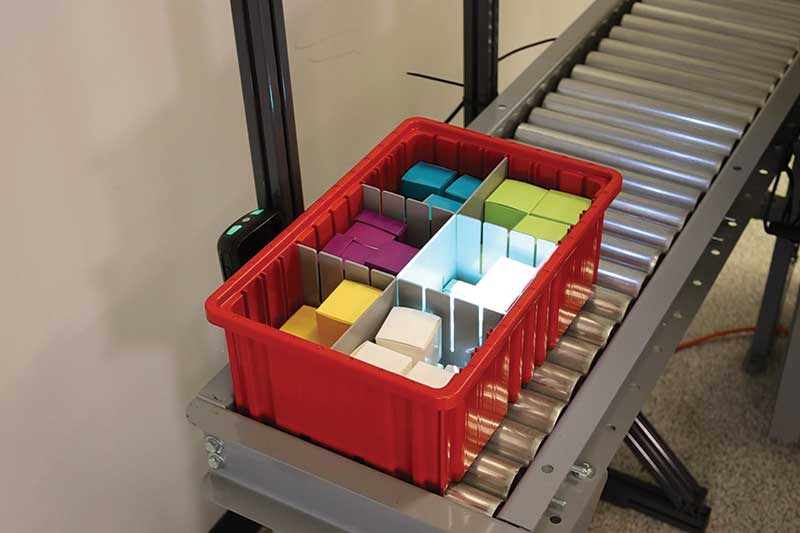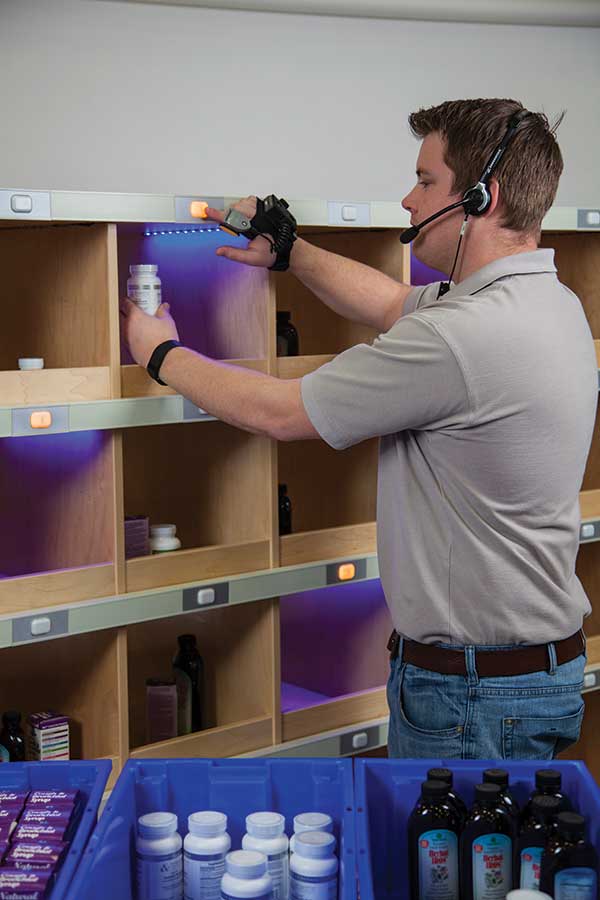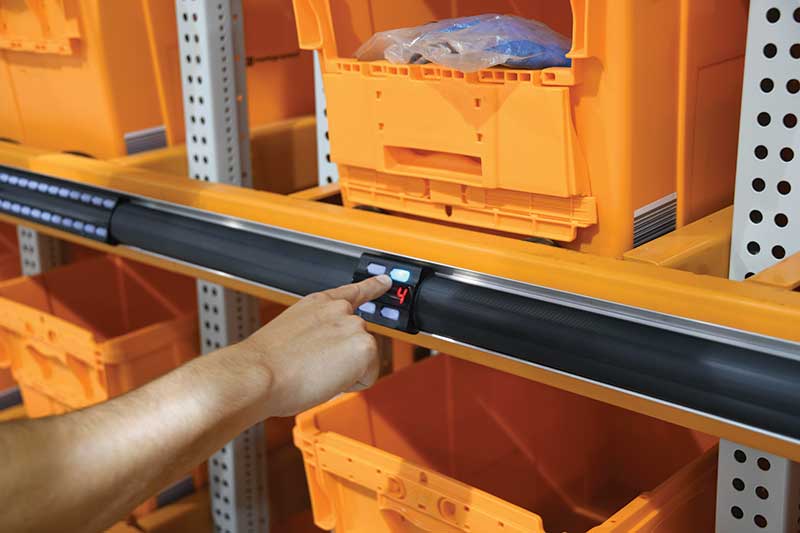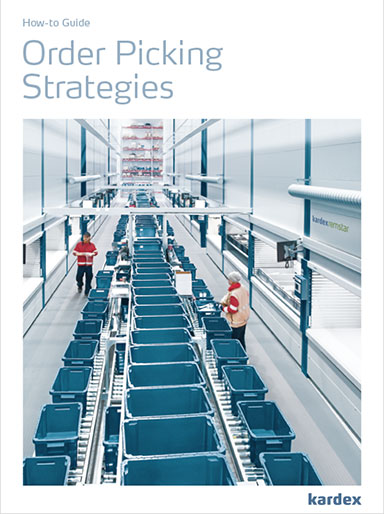Light-directed systems meet integrated solutions
Rather than being just stand-alone solutions for order picking and consolidation, pick-to-light is increasingly being used in the context of integrated solutions, while new twists on light technology open up new application areas.
Pick-to-light systems are proven solutions for warehouse fulfillment, especially when it comes to picking small items in a compact zone. In a typical application, a scan of an order tote by the picker activates the system, quickly showing the picker each SKU’s location and quantity to pick.
With minimal walking involved in pick-to-light modules, and no need to constantly reference a device screen or pick list, these systems speed up order picking compared to traditional processes where associates walk up and down aisles. Much can be said about light-driven put walls, which are used to consolidate orders.
However, in the decades since pick-to-light emerged, much has changed with fulfillment technology. Approaches like assistive picking autonomous mobile robots (AMR) or automated storage and retrieval (AS/RS) offer other means of efficient picking, and voice-directed systems have evolved and grown in popularity, making light-directed systems just one option.
Pick-to-light is no longer the shiny new order picking technology, however light-directed solutions are evolving with some technology twists, and they can be paired with other systems to create hybrid solutions. Additionally, lights can be well suited to applications outside of warehouses, such as guiding the selection of components in manufacturing assembly. It adds up to new possibilities for light-directed systems.

Evolving technology
One recent lights innovation from Matthews Automation and its Lighting Pick brand is its Projection Picking System. Rather than light modules or strips, Projection Picking uses laser projectors that shoot a beam of light to indicate location, says Bernie McCabe, sales manager for Matthews Automation, and the units also project other information such as product images, instructions or even video.
“On its face, it’s a way to replace the need for a physical layer of lights, but it’s more than that because it can also project images or other information. That allows the projection of instructions or images to provide added guidance to operators for applications like serialized assembly or kitting in manufacturing. It’s coming on in a major way in manufacturing because it can do more than indicate location and quantity.” - Bernie McCabe
McCabe says a more traditional pick-to-light module or put wall may still be a strong fit for many operations, but projection opens up new possibilities when it comes to quick reference to work instructions, or to show an image of a component or SKU. Additionally, it’s possible to have traditional light modules and projection working together.
“We’ve also seen some interest in lights and projection working in combination with one another in a hybrid way,” says McCabe. “For example, you might have an AMR that’s arriving at a location without the benefit of lights, so you could choose to do a projected image on top of it to guide accurate unloading and put away of items, but then you could have the operator at that station using a more traditional pick-to-light to guide serialized assembly. In some scenarios, projection and traditional lights can play well together.”
Pick-to-light can be used on mobile carts as well, McCabe says. One of Matthews Automation’s customers, third-party logistics company Capacity LLC, uses light-enabled batch picking carts to guide associates in batch picking multiple orders into totes to maximize efficient warehouse travel.
The totes then travel to light-driven put walls to be scanned and sorted to individual e-commerce orders. Matthews Automation’s Lighting Pick software platform supports both applications, while its warehouse execution software governs the overall flow of work and other automation at the site. Such integrated combinations, says McCabe, are becoming more common.
“Increasingly, we are seeing how these light-enabled workflows can be combined with one another as opposed to 20 or 25 years ago, when it’s fair to say that pick-to-light was much more of a single-point solution,” says McCabe. “That’s now changing where users are looking for opportunities to gain efficiencies from hybrid systems where multiple workflows can be supported using our platform.”
Blending technologies

Dan Hanrahan, CEO of warehouse integrator and software company Numina Group, says lights are increasingly being used as part of multi-mode solutions that blend voice, wearables, lights, and sometimes, AMR-based goods-to-person (GTP) solutions.
For example, Numina integrates the PopPick AMR solution from Geek+, which is a GTP system in which mobile robots transport mobile shelves with goods needed to fulfill orders to a workstation. Goods picked at the GTP workstation are placed by associates to compact, light-driven order shelves on either side of the workstation for order consolidation to totes ready for packing.
The order shelves function like a two-sided put wall, Hanrahan explains, using lights to direct putting from the workstation to the assigned order shelf locations. On the back side of the shelves, operators are equipped with voice and wearables, and directed by Numina’s voice software to pack out completed orders into the correct-sized shipping cartons.
Additionally, with Numina’s voice system, a wearable device with scanning is used, which allows for a combination of voice, short messages displayed on the device, and bar code scanning.
“On the front side of the order shelves, lights are used to direct the work, and on the backside, it’s voice-directed packing,” says Hanrahan. “We can use lights and voice collectively, as they work well together for order consolidation.”
There remain some scenarios in which traditional pick-to-light works well, adds Hanrahan, in particular when an operation has a high volume of fast-moving smaller items to fulfill. However, adds Hanrahan, if the SKU mix lacks a concentration of faster moving, relatively small products, it may be better to spread out the pick faces and use voice.
“We’ll do an analysis with the customer’s data to determine if lights do make sense for a picking application based on the SKU velocity,” Hanrahan says.
Lights can be used in unexpected areas, adds Hanrahan, such as at pack out stations where you have multiple types of catalogs, promotional flyers or other documents to insert into orders. A light-driven module at a pack out station can be triggered by Numina’s software to visually direct workers which documents from which cubbies should be inserted into specific orders based on pack and ship logic.
To support a more multi-modal approach, adds Hanrahan, Numina Group’s software is architected to communicate the same tasks to different technologies—lights, wearable devices or voice headsets. That common software layer, he explains, simplifies the creation of hybrid solutions, and makes for consistent reporting and metrics on picking and labor productivity.
Going mobile
Light display devices can be mobile and wireless, making them easy to attach to picking carts, or totes, or move from position to position, says Trevor Blumenau, founder and CEO of Voodoo Robotics, which offers wireless light devices that run on AAA batteries. That makes the devices well suited to shelving on carts or in pick modules that may need to be reconfigured, he adds.
“If you are a third-party logistics provider and you lose one customer at a site and gain a different one, and need to reconfigure your warehouse, you can just move these devices around very simply,” says Blumenau. “That ease of reconfiguration removes risk being able to adapt your system.”
Voodoo’s lights have displays that can show five lines of text, including arrow symbols to point to different locations with one light. This scrolling display along with being wireless is key to application flexibility, adds Blumenau, while a REST API allows for full integration to back-end systems like warehouse management to support applications like mobile, light-guided batch picking to a cart.
One manufacturing customer is deploying Voodoo’s cloud display devices on steel tanks in its production facility, says Blumenau, to indicate to operators which valves to open and for how long, as a visual work instruction. “That’s why we call them cloud display devices, because they can show more information than a traditional pick-to-light device,” he says.
Pick-to-light can be used on mobile carts, agrees Robb Weidemann, vice president of product management for Banner Engineering, a supplier of automation products including pick-to-light kits. Programmable features and text display provide versatility for applications, he says. For example, some of Banner’s lights have a programmable secondary button, which can be configured so operators can just push a button to trigger restocking of a bin or cubby running low.
Pick-to-light has long been used not just in warehousing, says Weidemann, but also in manufacturing and assembly operations to guide the kitting of goods that need to be brought to work cells, or at work cells to guide assembly, where there may similar-sized fasteners or parts that need to be selected accurately and quickly.
The ongoing challenge of finding enough labor in both manufacturing and warehousing, adds Weidemann, makes lights an ideal user interface because it’s easy for new employees to learn how to follow light guidance.
“With the tight labor market and high turnover rates, our customers find that a big advantage of pick-to-light is in its speed of training, so new workers can be onboarded quickly,” he says.
Steady appeal
While pick-to-light systems and light-driven put walls remain viable choices, today other types of order picking solutions have a higher degree of automation, like shuttles. What traditional pick-to-light has going for is its price, says Ernie Bocchino, director of software development and engineering for DMW&H, a warehouse integrator and software provider.
“If you can establish a pick-to-light zone in which the picks are very close to one another, it can work well,” says Bocchino. “But there are other more highly automated choices. One thing that pick-to-light has going for it, is that is a relatively low cost if you’re looking for a bump up in pick rate and accuracy compared with a more manual process.”
Pick-to-light systems and put walls have ongoing fit and appeal in fulfillment operations, says Keith Fisher, president of Honeywell Intelligrated, which uses lights in some of its automation solutions.
“Light-directed solutions are most efficient when you have a dedicated set of people working in a specific area of the warehouse,” Fisher says. “For example, if you have an order tote traveling down a track and workers picking from a zone, lights can help workers quickly and easily identify the parts they need to grab for these orders.”
But lights may also get leveraged in some GTP solutions, agrees Fisher. “Decanting and picking using lights at GTP stations also has proven to increase both user efficiency and accuracy,” he adds. “Overall, lights provide an easy and efficient way for operators to perform actions with limited training, thus creating an optimized workflow with almost no room for user error to meet the aggressive shipping windows of the e-commerce industry.”
The upshot is that while more highly automated approaches are out there today, traditional lights may suit operational needs and budgets, and they get leverage in other ways, too, so don’t expect lights to go away.
“We see continued usage and dependence on light-based picking and putting solutions,” Fisher says. “It has long been known to be one of the fastest, most accurate methods for picking. Robotic storage retrieval and sortation solutions may reduce the need for human-centered methods like lights, and a greenfield DC can be built today using 100% robotics and fewer labor resources—the ‘Dark Warehouse.’ However, if there are Tier 2 and 3 distribution facilities where return on operational facilities is paramount, light-based picking will be a viable and competitive alternative.”













